Enhanced Thermal and Dynamic Mechanical Properties of Synthetic/Natural Hybrid Composites with Graphene Nanoplateletes
Abstract
1. Introduction
2. Materials and Methods
2.1. Materials
2.2. Fabrication of Graphene Nanoplatelets (GNP) Modified Laminated Composites
2.3. Experimentation
2.3.1. Thermogravimetric Analysis (TGA)
2.3.2. Differential Scanning Calorimetry (DSC)
2.3.3. Dynamic Mechanical Analysis (DMA)
3. Results and Discussion
3.1. Thermogravimetric Analysis (TGA)
3.2. Differential Scanning Calorimetry
3.3. Dynamic Mechanical Analysis (DMA)
3.3.1. Storage Modulus (E’)
3.3.2. Loss Modulus (E”)
3.3.3. Tan Delta (Tanδ)
3.3.4. Cole–Cole Plot
4. Conclusions
Author Contributions
Funding
Conflicts of Interest
References
- Jawaid, M.; Khalil, H.A.; Alattas, O.S. Woven hybrid biocomposites: Dynamic mechanical and thermal properties. Compos. A Appl. Sci. Manuf. 2012, 43, 288–293. [Google Scholar] [CrossRef]
- Shah, D.U.; Schubel, P.J.; Clifford, M.J. Can flax replace E-glass in structural composites? A small wind turbine blade case study. Compos. B Eng. 2013, 52, 172–181. [Google Scholar] [CrossRef]
- Sathishkumar, T.; Naveen, J.A.; Satheeshkumar, S. Hybrid fiber reinforced polymer composites—A review. J. Reinf. Plast. Compos. 2014, 33, 454–471. [Google Scholar] [CrossRef]
- Zhang, J.; Ju, S.; Jiang, D.; Peng, H.-X. Reducing dispersity of mechanical properties of carbon fiber/epoxy composites by introducing multi-walled carbon nanotubes. Compos. B Eng. 2013, 54, 371–376. [Google Scholar] [CrossRef]
- Roe, P.; Ansell, M.P. Jute-reinforced polyester composites. J. Mater. Sci. 1985, 20, 4015–4020. [Google Scholar] [CrossRef]
- Joshi, S.V.; Drzal, L.; Mohanty, A.; Arora, S. Are natural fiber composites environmentally superior to glass fiber reinforced composites? Compos. A Appl. Sci. Manuf. 2004, 35, 371–376. [Google Scholar] [CrossRef]
- Nurul Hidayah, I.; Nuur Syuhada, D.; Abdul Khalil, H.P.S.; Ishak, Z.A.M.; Mariatti, M. Enhanced performance of lightweight kenaf-based hierarchical composite laminates with embedded carbon nanotubes. Mater. Des. 2019, 171, 107710. [Google Scholar] [CrossRef]
- Wambua, P.; Ivens, J.; Verpoest, I. Natural fibres: Can they replace glass in fibre reinforced plastics? Compos. Sci. Technol. 2003, 63, 1259–1264. [Google Scholar] [CrossRef]
- Reddy, K.O.; Reddy, G.S.; Maheswari, C.U.; Rajulu, A.V.; Rao, K.M. Structural characterization of coconut tree leaf sheath fiber reinforcement. J. For. Res. 2010, 21, 53–58. [Google Scholar] [CrossRef]
- Naveen, J.; Jawaid, M.; Zainudin, E.; Sultan, M.T.; Yahaya, R.; Majid, M.A. Thermal degradation and viscoelastic properties of Kevlar/Cocos nucifera sheath reinforced epoxy hybrid composites. Compos. Struct. 2019. [Google Scholar] [CrossRef]
- Espert, A.; Vilaplana, F.; Karlsson, S. Comparison of water absorption in natural cellulosic fibres from wood and one-year crops in polypropylene composites and its influence on their mechanical properties. Compos. A Appl. Sci. Manuf. 2004, 35, 1267–1276. [Google Scholar] [CrossRef]
- Pothan, L.; Cherian, B.; Anandakutty, B.; Thomas, S. Effect of layering pattern on the water absorption behavior of banana glass hybrid composites. J. Appl. Polym. Sci. 2007, 105, 2540–2548. [Google Scholar] [CrossRef]
- Costa, C.; Fonseca, A.; Serra, A.; Coelho, J. Dynamic mechanical thermal analysis of polymer composites reinforced with natural fibers. Polym. Rev. 2016, 56, 362–383. [Google Scholar] [CrossRef]
- Hossain, M.K.; Chowdhury, M.M.R.; Bolden, N.W. Processing and Performance Evaluation of Amine Functionalized Graphene Nanoplatelet Reinforced Epoxy Composites. J. Mater. Sci. Eng. A 2016, 6, 117–130. [Google Scholar]
- Geng, Y.; Liu, M.Y.; Li, J.; Shi, X.M.; Kim, J.K. Effects of surfactant treatment on mechanical and electrical properties of CNT/epoxy nanocomposites. Mater. Sci. Eng. A 2008, 39, 1876–1883. [Google Scholar] [CrossRef]
- Spitalsky, Z.; Tasis, D.; Papagelis, K.; Galiotis, C. Carbon nanotube–polymer composites: Chemistry, processing, mechanical and electrical properties. Prog. Polym. Sci. 2010, 35, 357–401. [Google Scholar] [CrossRef]
- Wang, F.; Drzal, L.T.; Qin, Y.; Huang, Z. Mechanical properties and thermal conductivity of graphene nanoplatelet/epoxy composites. J. Mater. Sci. 2015, 50, 1082–1093. [Google Scholar] [CrossRef]
- Park, S.; Ruoff, R.S. Chemical methods for the production of graphenes. Nat. Nanotechnol. 2009, 4, 217. [Google Scholar] [CrossRef] [PubMed]
- Stankovich, S.; Dikin, D.A.; Dommett, G.H.; Kohlhaas, K.M.; Zimney, E.J.; Stach, E.A.; Piner, R.D.; Nguyen, S.T.; Ruoff, R.S. Graphene-based composite materials. Nature 2006, 442, 282. [Google Scholar] [CrossRef]
- Eda, G.; Chhowalla, M. Graphene-based composite thin films for electronics. Nano Lett. 2009, 9, 814–818. [Google Scholar] [CrossRef]
- Liang, J.; Xu, Y.; Huang, Y.; Zhang, L.; Wang, Y.; Ma, Y.; Li, F.; Guo, T.; Chen, Y. Infrared-triggered actuators from graphene-based nanocomposites. J. Phys. Chem. C 2009, 113, 9921–9927. [Google Scholar] [CrossRef]
- Monteiro, S.N.; Calado, V.; Rodriguez, R.J.S.; Margem, F.M. Thermogravimetric behavior of natural fibers reinforced polymer composites—An overview. Mater. Sci. Eng. A 2012, 557, 17–28. [Google Scholar] [CrossRef]
- Chee, S.S.; Jawaid, M.; Sultan, M.; Alothman, O.Y.; Abdullah, L.C. Evaluation of the hybridization effect on the thermal and thermo-oxidative stability of bamboo/kenaf/epoxy hybrid composites. J. Therm. Anal. Calorim. 2018, 1–9. [Google Scholar] [CrossRef]
- Jarukumjorn, K.; Suppakarn, N. Effect of glass fiber hybridization on properties of sisal fiber–polypropylene composites. Compos. B Eng. 2009, 40, 623–627. [Google Scholar] [CrossRef]
- Atiqah, A.; Jawaid, M.; Sapuan, S.; Ishak, M. Dynamic mechanical properties of sugar palm/glass fiber reinforced thermoplastic polyurethane hybrid composites. Polym. Compos. 2018. [Google Scholar] [CrossRef]
- Nayak, S.K.; Mohanty, S.; Samal, S.K. Influence of short bamboo/glass fiber on the thermal, dynamic mechanical and rheological properties of polypropylene hybrid composites. Mater. Sci. Eng. A 2009, 523, 32–38. [Google Scholar] [CrossRef]
- Rasana, N.; Jayanarayanan, K.; Deeraj, B.; Joseph, K. The thermal degradation and dynamic mechanical properties modeling of MWCNT/glass fiber multiscale filler reinforced polypropylene composites. composites. Compos. Sci. Technol. 2019, 169, 249–259. [Google Scholar] [CrossRef]
- Mourad, A.-H.; Fouad, H.; Elleithy, R. Impact of some environmental conditions on the tensile, creep-recovery, relaxation, melting and crystallinity behaviour of UHMWPE-GUR 410-medical grade. Mater. Des. 2009, 30, 4112–4119. [Google Scholar] [CrossRef]
- Md Shah, A.U.; Sultan, M.T.; Jawaid, M. Sandwich-structured bamboo powder/glass fibre-reinforced epoxy hybrid composites–Mechanical performance in static and dynamic evaluations. J. Sandw. Struct. Mater. 2019. [Google Scholar] [CrossRef]
- Saba, N.; Jawaid, M.; Alothman, O.Y.; Paridah, M. A review on dynamic mechanical properties of natural fibre reinforced polymer composites. Constr. Build. Mater. 2016, 106, 149–159. [Google Scholar] [CrossRef]
- Candan, Z.; Gardner, D.J.; Shaler, S.M. Dynamic mechanical thermal analysis (DMTA) of cellulose nanofibril/nanoclay/pMDI nanocomposites. Compos. B Eng. 2016, 90, 126–132. [Google Scholar] [CrossRef]
- Saba, N.; Safwan, A.; Sanyang, M.; Mohammad, F.; Pervaiz, M.; Jawaid, M.; Alothman, O.; Sain, M. Thermal and dynamic mechanical properties of cellulose nanofibers reinforced epoxy composites. Int. J. Biol. Macromol. 2017, 102, 822–828. [Google Scholar] [CrossRef]
- Atiqah, A.; Jawaid, M.; Sapuan, S.; Ishak, M.; Alothman, O.Y. Thermal properties of sugar palm/glass fiber reinforced thermoplastic polyurethane hybrid composites. Compos. Struct. 2018, 202, 954–958. [Google Scholar] [CrossRef]
- Devi, L.U.; Bhagawan, S.; Thomas, S. Dynamic mechanical analysis of pineapple leaf/glass hybrid fiber reinforced polyester composites. Polym. Compos. 2010, 31, 956–965. [Google Scholar] [CrossRef]
- Cheng, F.; Hu, Y.; Yuan, J. Preparation and characterization of glass fiber-coir hybrid composites by a novel and facile Prepreg/Press process. Fiber Polym. 2014, 15, 1715–1721. [Google Scholar] [CrossRef]
- Samal, S.K.; Mohanty, S.; Nayak, S.K. Polypropylene—bamboo/glass fiber hybrid composites: Fabrication and analysis of mechanical, morphological, thermal, and dynamic mechanical behavior. Reinf. Plast. Compos. 2009, 28, 2729–2747. [Google Scholar] [CrossRef]
- Pedrazzoli, D.; Pegoretti, A. Hybridization of short glass fiber polypropylene composites with nanosilica and graphite nanoplatelets. Reinf. Plast. Compos. 2014, 33, 1682–1695. [Google Scholar] [CrossRef]
- Wang, F.; Drzal, L.T.; Qin, Y.; Huang, Z. Size effect of graphene nanoplatelets on the morphology and mechanical behavior of glass fiber/epoxy composites. J. Mater. Sci. 2016, 51, 3337–3348. [Google Scholar] [CrossRef]
- Naveen, J.; Jawaid, M.; Zainudin, E.S.; Thariq Hameed Sultan, M.; Yahaya, R. Improved Mechanical and Moisture-Resistant Properties of Woven Hybrid Epoxy Composites by Graphene Nanoplatelets (GNP). Materials 2019, 12, 1249. [Google Scholar] [CrossRef]
- Mandal, A.; Chakrabarty, D. Studies on the mechanical, thermal, morphological and barrier properties of nanocomposites based on poly (vinyl alcohol) and nanocellulose from sugarcane bagasse. J. Ind. Eng. Chem. 2014, 20, 462–473. [Google Scholar] [CrossRef]
- Sen, A.; Kumar, S. Coir-fiber-based fire retardant nano filler for epoxy composites. J. Therm. Anal. Calorim. 2010, 101, 265–271. [Google Scholar] [CrossRef]
- Kim, H.-S.; Yang, H.-S.; Kim, H.-J.; Park, H.-J. Thermogravimetric analysis of rice husk flour filled thermoplastic polymer composites. J. Therm. Anal. Calorim. 2004, 76, 395–404. [Google Scholar]
- Fan, J.; Wang, J.; Shi, Z.; Yu, S.; Yin, J. Kevlar nanofiber-functionalized multiwalled carbon nanotubes for polymer reinforcement. Mater. Chem. Phys. 2013, 141, 861–868. [Google Scholar] [CrossRef]
- Kang, C.H.; Yoon, K.H.; Park, Y.-B.; Lee, D.-Y.; Jeong, S.-S. Properties of polypropylene composites containing aluminum/multi-walled carbon nanotubes. Compos. A Appl. Sci. Manuf. 2010, 41, 919–926. [Google Scholar] [CrossRef]
- Mourad, A.-H.I. Thermo-mechanical characteristics of thermally aged polyethylene/polypropylene blends. Mater. Des. 2010, 31, 918–929. [Google Scholar] [CrossRef]
- Abu-Jdayil, B.; Mourad, A.H.; Hassan, M. Development of polymeric heat insulators based on emirati red shale filler: Thermal and physical properties. Polym. Compos. 2018, 39, E1463–E1473. [Google Scholar] [CrossRef]
- Hsieh, T.; Kinloch, A.; Masania, K.; Taylor, A.; Sprenger, S. The mechanisms and mechanics of the toughening of epoxy polymers modified with silica nanoparticles. Polymer 2010, 51, 6284–6294. [Google Scholar] [CrossRef]
- Mourad, A.-H.I.; Zaaroura, N. Impact of Nanofillers Incorporation on Laminated Nanocomposites Performance. J. Mater. Eng. Perform. 2018, 27, 4453–4461. [Google Scholar] [CrossRef]
- Vallés, C.; Beckert, F.; Burk, L.; Mülhaupt, R.; Young, R.J.; Kinloch, I.A. Effect of the C/O ratio in graphene oxide materials on the reinforcement of epoxy-based nanocomposites. J. Polym. Sci. B 2016, 54, 281–291. [Google Scholar] [CrossRef]
- Gu, J.; Yang, X.; Lv, Z.; Li, N.; Liang, C.; Zhang, Q. Functionalized graphite nanoplatelets/epoxy resin nanocomposites with high thermal conductivity. Int. J. Heat Mass Transf. 2016, 92, 15–22. [Google Scholar] [CrossRef]
- Xia, T.; Zeng, D.; Li, Z.; Young, R.J.; Vallés, C.; Kinloch, I.A. Electrically conductive GNP/epoxy composites for out-of-autoclave thermoset curing through Joule heating. Compos. Sci. Technol. 2018, 164, 304–312. [Google Scholar] [CrossRef]
- Asim, M.; Jawaid, M.; Nasir, M.; Saba, N. Effect of fiber loadings and treatment on dynamic mechanical, thermal and flammability properties of pineapple leaf fiber and kenaf phenolic composites. J. Renew. Mater. 2018, 6, 383–393. [Google Scholar] [CrossRef]
- Joseph, S.; Appukuttan, S.P.; Kenny, J.M.; Puglia, D.; Thomas, S.; Joseph, K. Dynamic mechanical properties of oil palm microfibril-reinforced natural rubber composites. J. Appl. Polym. Sci. 2010, 117, 1298–1308. [Google Scholar] [CrossRef]
- Hameed, N.; Sreekumar, P.; Francis, B.; Yang, W.; Thomas, S. Morphology, dynamic mechanical and thermal studies on poly (styrene-co-acrylonitrile) modified epoxy resin/glass fibre composites. Compos. A Appl. Sci. Manuf. 2007, 38, 2422–2432. [Google Scholar] [CrossRef]
- Braga, R.; Magalhaes, P., Jr. Analysis of the mechanical and thermal properties of jute and glass fiber as reinforcement epoxy hybrid composites. Mater. Sci. Eng. C 2015, 56, 269–273. [Google Scholar] [CrossRef]
- Nair, K.M.; Thomas, S.; Groeninckx, G. Thermal and dynamic mechanical analysis of polystyrene composites reinforced with short sisal fibres. Compos. Sci. Technol. 2001, 61, 2519–2529. [Google Scholar] [CrossRef]
- Idicula, M.; Malhotra, S.; Joseph, K.; Thomas, S. Dynamic mechanical analysis of randomly oriented intimately mixed short banana/sisal hybrid fibre reinforced polyester composites. Compos. Sci. Technol. 2005, 65, 1077–1087. [Google Scholar] [CrossRef]

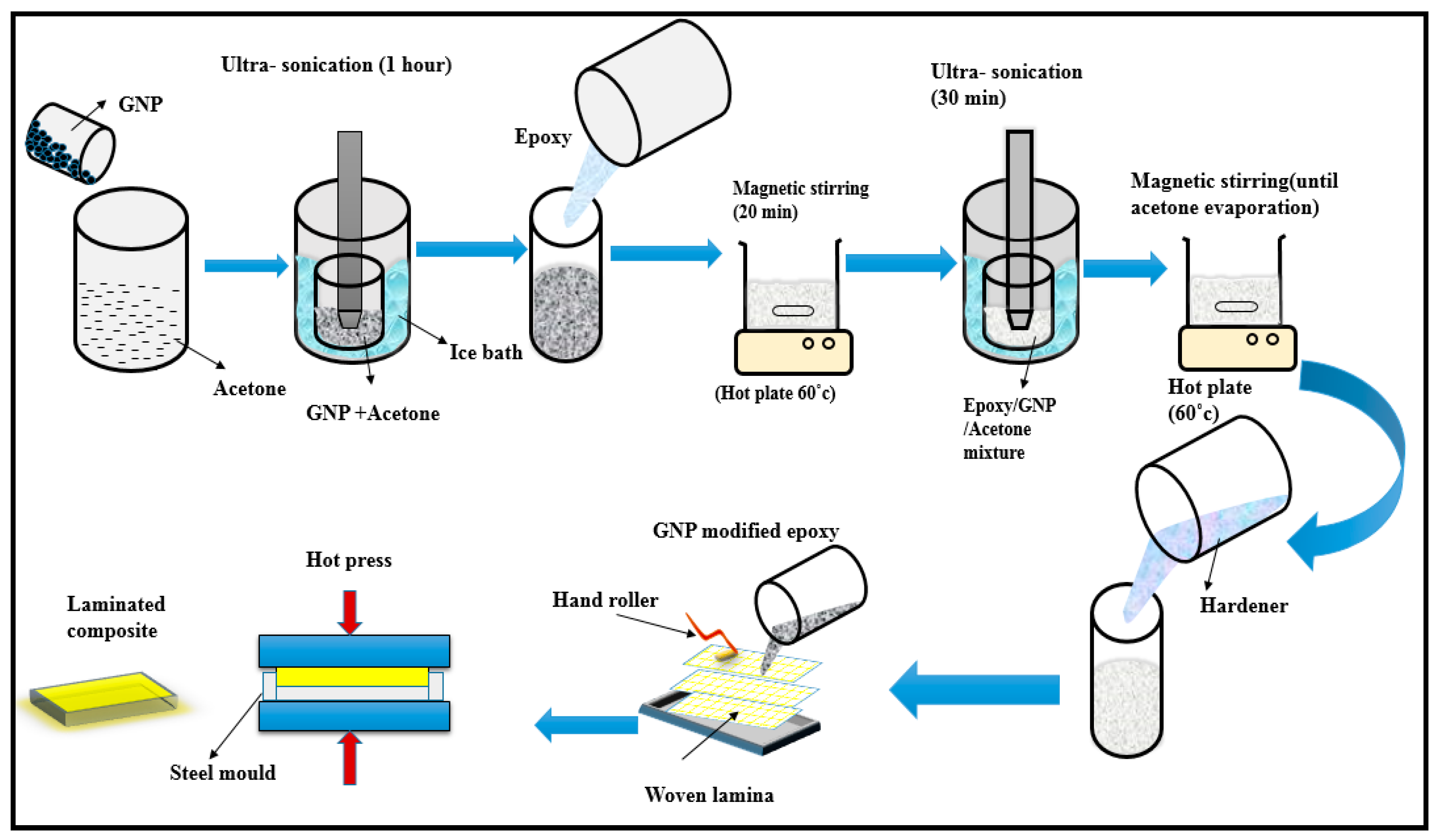
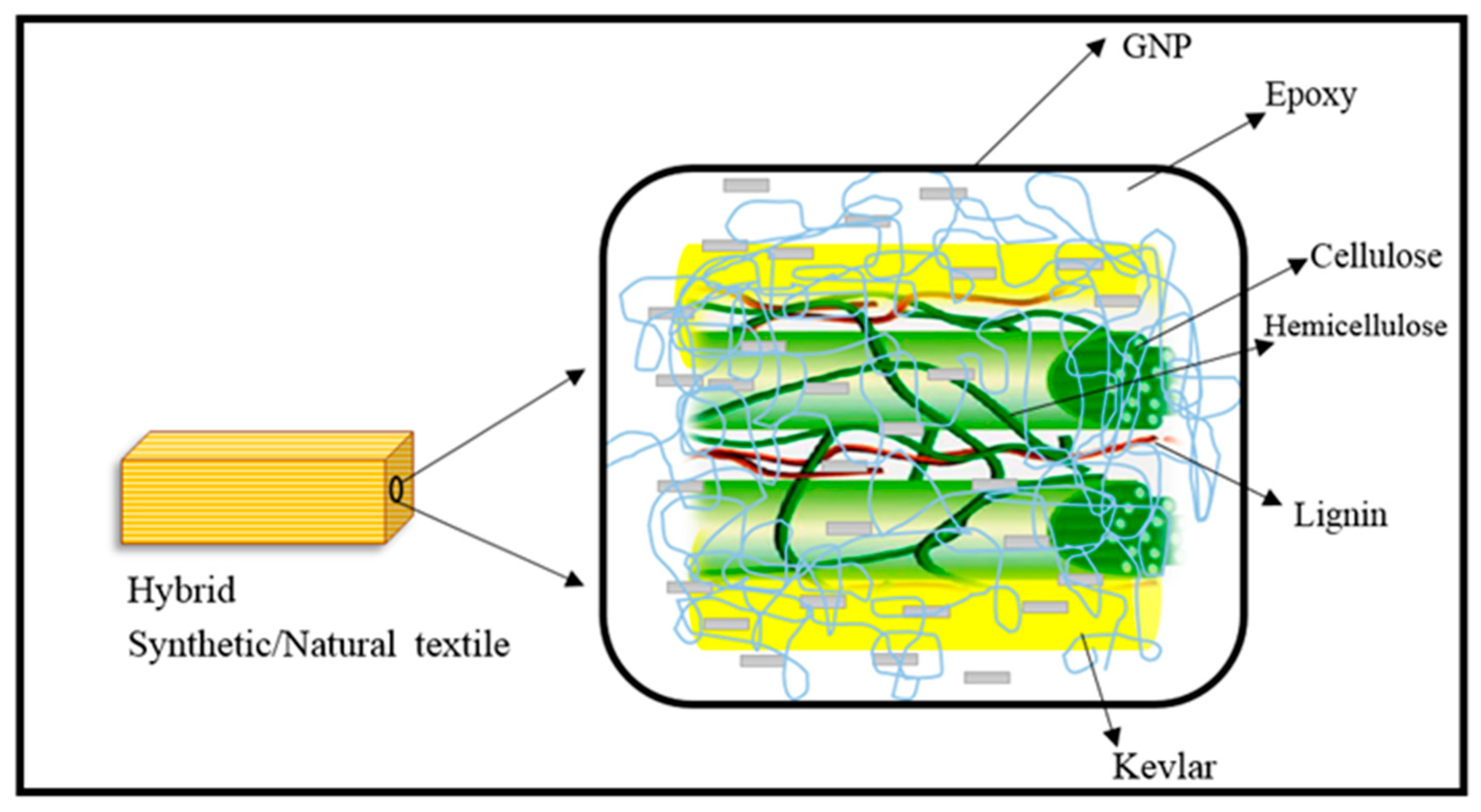

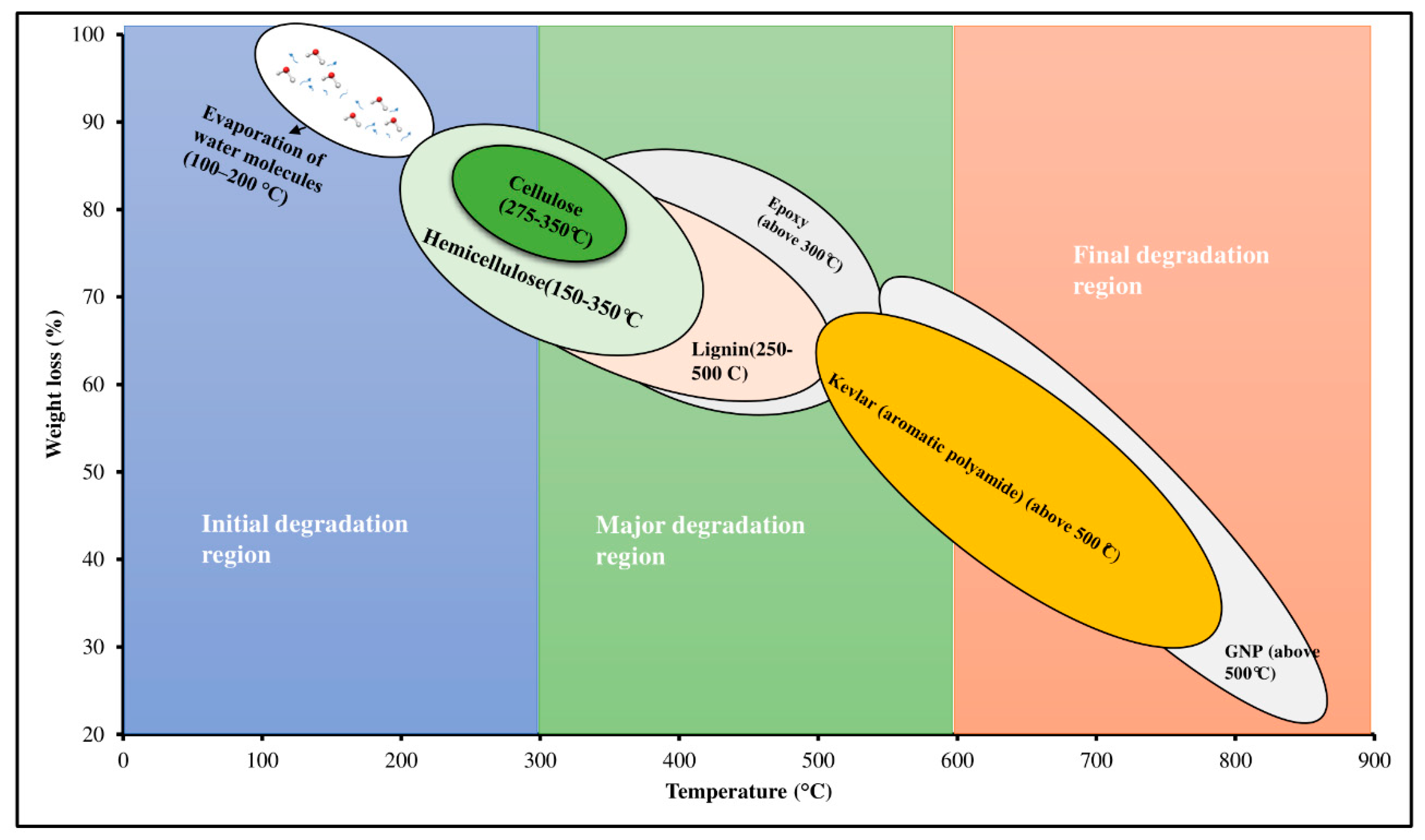
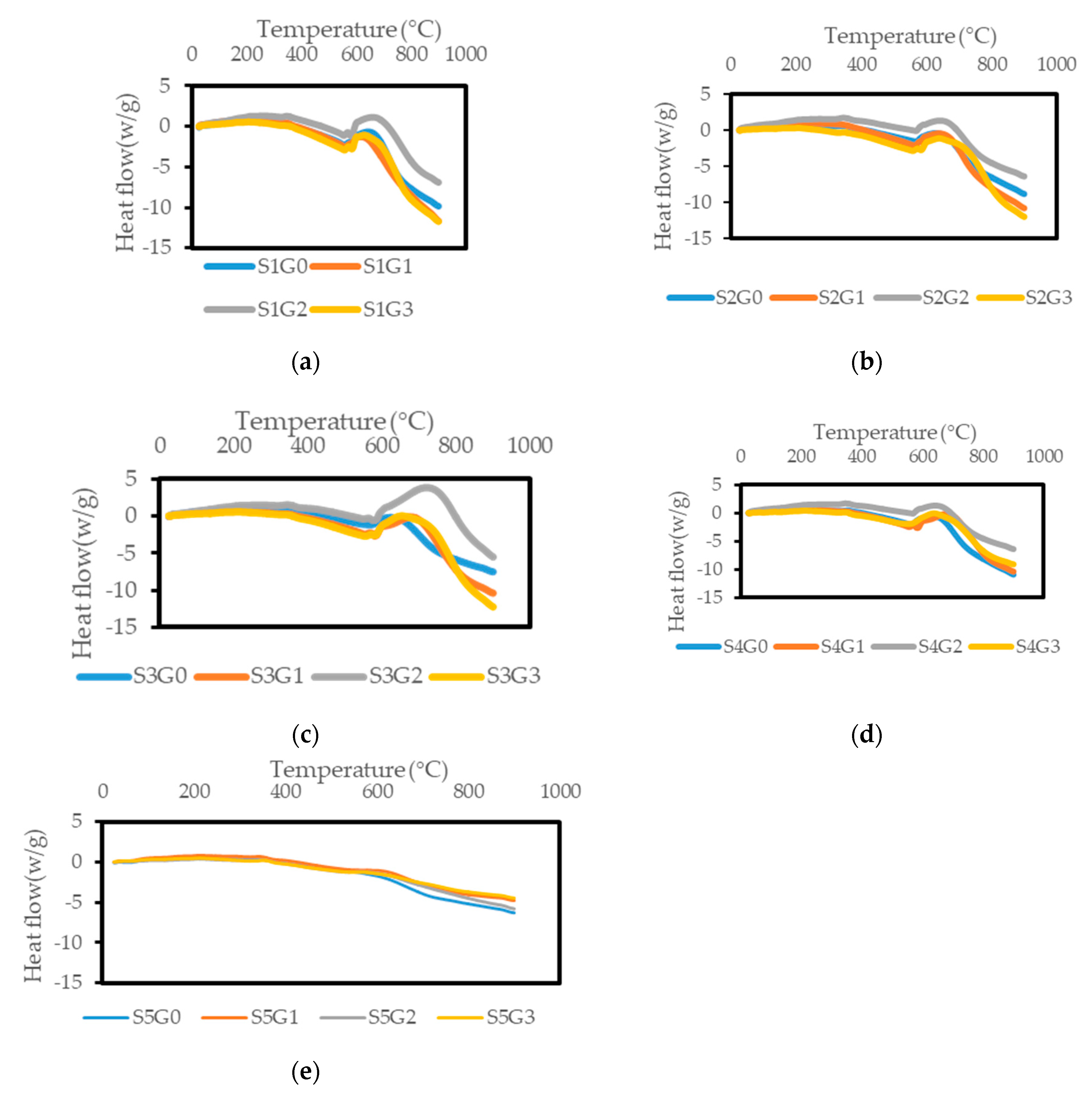
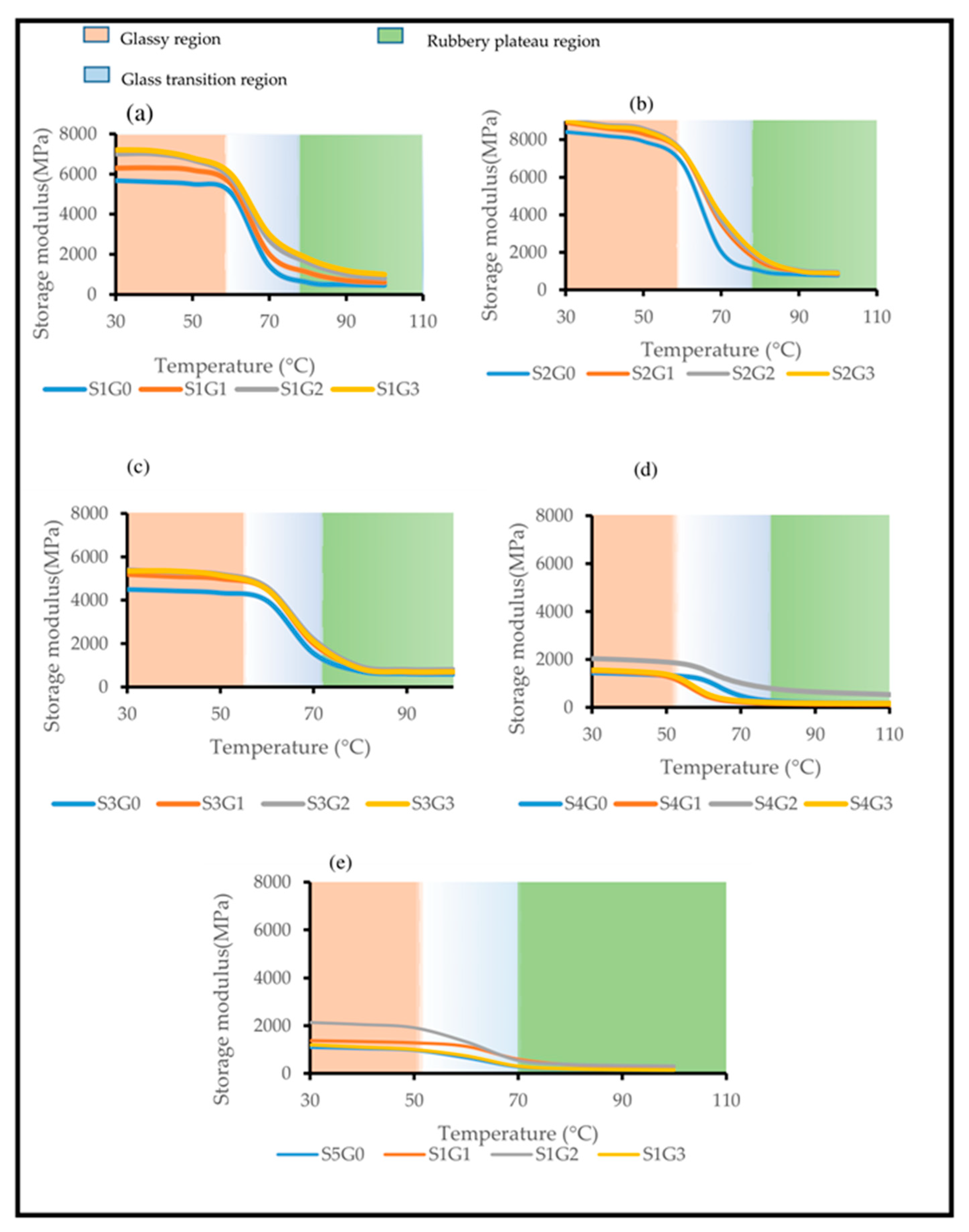
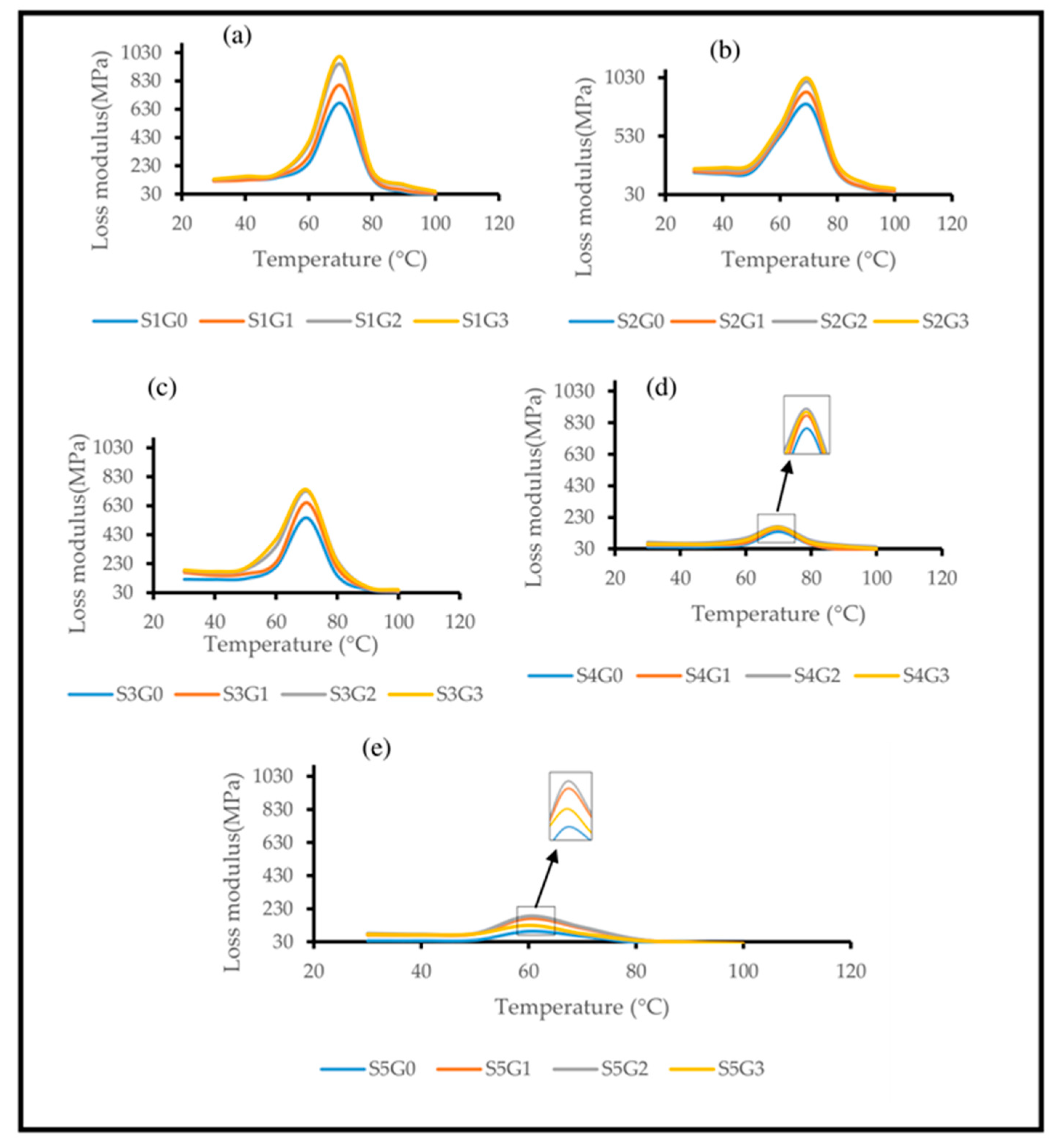
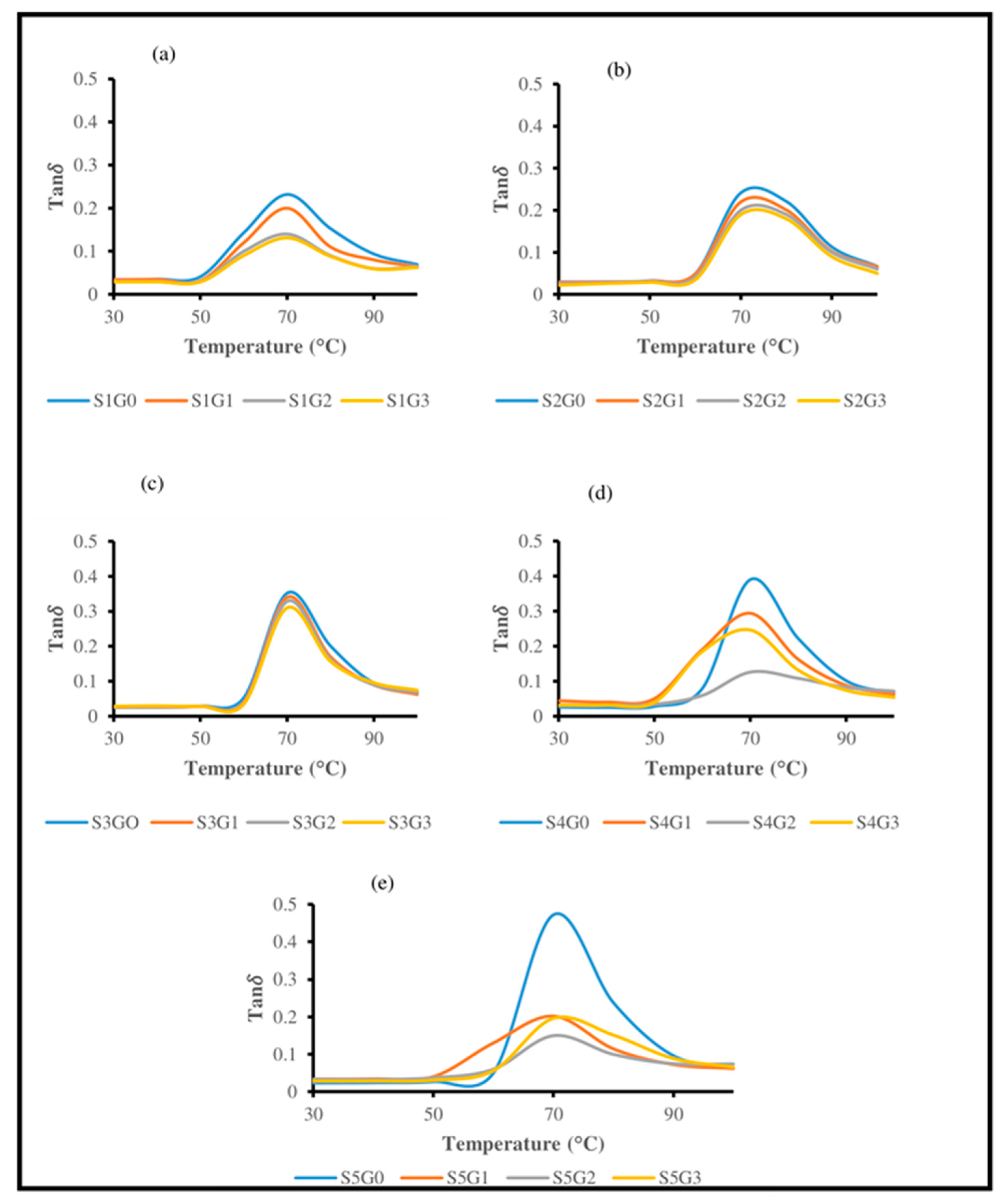

| Sl.No | Symbol | No of Layers | Layering Sequence | GNP (wt.%) | |
|---|---|---|---|---|---|
| Kevlar | CS | ||||
| 1. | S1G0 | 4 | 0 |  | 0 |
| 2. | S1G1 | 4 | 0 | 0.25 | |
| 3. | S1G2 | 4 | 0 | 0.50 | |
| 4. | S1G3 | 4 | 0 | 0.75 | |
| 5. | S2G0 | 3 | 1 |  | 0 |
| 6. | S2G1 | 3 | 1 | 0.25 | |
| 7. | S2G2 | 3 | 1 | 0.50 | |
| 8. | S2G3 | 3 | 1 | 0.75 | |
| 9. | S3G0 | 2 | 2 |  | 0 |
| 10. | S3G1 | 2 | 2 | 0.25 | |
| 11. | S3G2 | 2 | 2 | 0.50 | |
| 12. | S3G3 | 2 | 2 | 0.75 | |
| 13. | S4G0 | 1 | 3 |  | 0 |
| 14. | S4G1 | 1 | 3 | 0.25 | |
| 15. | S4G2 | 1 | 3 | 0.50 | |
| 16. | S4G3 | 1 | 3 | 0.75 | |
| 17. | S5G0 | 0 | 4 |  | 0 |
| 18. | S5G1 | 0 | 4 | 0.25 | |
| 19. | S5G2 | 0 | 4 | 0.50 | |
| 20. | S5G3 | 0 | 4 | 0.75 | |
 , CS
, CS  .
.| Laminated Composites | Major Degradation Temperature (°C) | Weight Loss (%) | Final Degradation Temp. (°C) | Char Residue (%) |
|---|---|---|---|---|
| S1G0 | 371 | 42.65 | 582 | 21.83 |
| S1G1 | 372 | 40.68 | 583 | 22.01 |
| S1G2 | 372 | 38.87 | 584 | 23.32 |
| S1G3 | 374 | 34.92 | 585 | 24.28 |
| S2G0 | 369 | 62.62 | 581 | 14.67 |
| S2G1 | 370 | 47.99 | 582 | 21.17 |
| S2G2 | 370 | 62.21 | 582 | 22.10 |
| S2G3 | 371 | 51.11 | 583 | 22.78 |
| S3GO | 366 | 66.76 | 579 | 14.19 |
| S3G1 | 367 | 40.33 | 583 | 16.71 |
| S3G2 | 369 | 46.62 | 583 | 19.86 |
| S3G3 | 371 | 52.37 | 583 | 22.87 |
| S4G0 | 365 | 68.79 | 570 | 12.23 |
| S4G1 | 366 | 63.10 | 581 | 15.36 |
| S4G2 | 367 | 58.98 | 582 | 16.50 |
| S4G3 | 369 | 69.01 | 582 | 17.75 |
| S5G0 | 363 | 73.82 | 390 | 11.12 |
| S5G1 | 364 | 73.57 | 391 | 12.22 |
| S5G2 | 365 | 75.96 | 391 | 11.81 |
| S5G3 | 366 | 66.96 | 391 | 11.76 |
| Laminates | Tg from E″ (°C) | Tg from Tanδ (°C) | Peak of Tanδ |
|---|---|---|---|
| S1G0 | 66.60 | 70.85 | 0.22 |
| S1G1 | 68.74 | 70.90 | 0.21 |
| S1G2 | 69.12 | 70.96 | 0.13 |
| S1G3 | 69.35 | 70.65 | 0.13 |
| S2G0 | 65.35 | 70.02 | 0.26 |
| S2G1 | 66.71 | 70.45 | 0.20 |
| S2G2 | 67.12 | 70.10 | 0.19 |
| S2G3 | 67.32 | 70.09 | 0.18 |
| S3GO | 67.50 | 71.47 | 0.36 |
| S3G1 | 68.42 | 71.68 | 0.34 |
| S3G2 | 69.58 | 71.86 | 0.32 |
| S3G3 | 69.89 | 71.34 | 0.31 |
| S4G0 | 68.21 | 74.00 | 0.38 |
| S4G1 | 69.71 | 74.16 | 0.29 |
| S4G2 | 71.21 | 74.52 | 0.12 |
| S4G3 | 68.76 | 74.19 | 0.24 |
| S5G0 | 62.22 | 67.77 | 0.46 |
| S5G1 | 62.25 | 67.86 | 0.19 |
| S5G2 | 63.94 | 68.10 | 0.15 |
| S5G3 | 62.21 | 67.98 | 0.19 |
© 2019 by the authors. Licensee MDPI, Basel, Switzerland. This article is an open access article distributed under the terms and conditions of the Creative Commons Attribution (CC BY) license (http://creativecommons.org/licenses/by/4.0/).
Share and Cite
Jesuarockiam, N.; Jawaid, M.; Zainudin, E.S.; Thariq Hameed Sultan, M.; Yahaya, R. Enhanced Thermal and Dynamic Mechanical Properties of Synthetic/Natural Hybrid Composites with Graphene Nanoplateletes. Polymers 2019, 11, 1085. https://doi.org/10.3390/polym11071085
Jesuarockiam N, Jawaid M, Zainudin ES, Thariq Hameed Sultan M, Yahaya R. Enhanced Thermal and Dynamic Mechanical Properties of Synthetic/Natural Hybrid Composites with Graphene Nanoplateletes. Polymers. 2019; 11(7):1085. https://doi.org/10.3390/polym11071085
Chicago/Turabian StyleJesuarockiam, Naveen, Mohammad Jawaid, Edi Syams Zainudin, Mohamed Thariq Hameed Sultan, and Ridwan Yahaya. 2019. "Enhanced Thermal and Dynamic Mechanical Properties of Synthetic/Natural Hybrid Composites with Graphene Nanoplateletes" Polymers 11, no. 7: 1085. https://doi.org/10.3390/polym11071085
APA StyleJesuarockiam, N., Jawaid, M., Zainudin, E. S., Thariq Hameed Sultan, M., & Yahaya, R. (2019). Enhanced Thermal and Dynamic Mechanical Properties of Synthetic/Natural Hybrid Composites with Graphene Nanoplateletes. Polymers, 11(7), 1085. https://doi.org/10.3390/polym11071085








